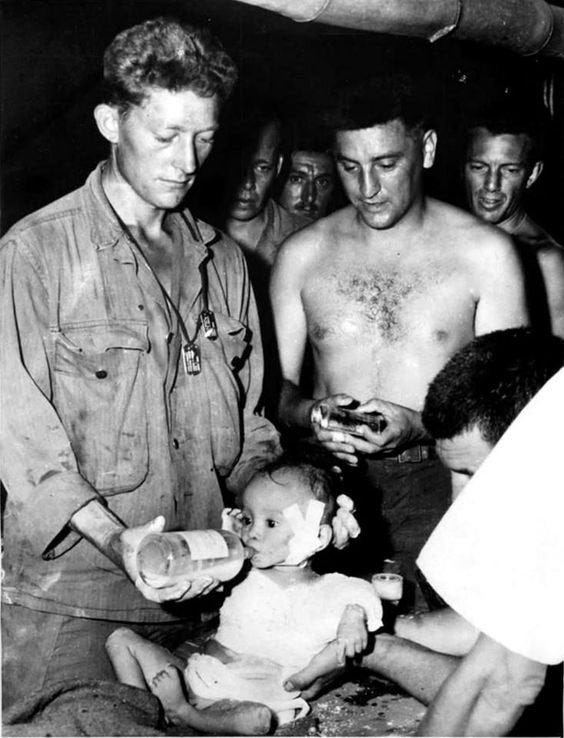 hen a war is fought on your own homeland, everything is on the line and as the biological pyramid goes, children are always put first. They are the future generation, they are the ones expected to rebuild the country and repopulate it once the war was over. Sadly, that was not the fate of Japanese babies and young children during the Pacific campaign near the end of World War II.
hen a war is fought on your own homeland, everything is on the line and as the biological pyramid goes, children are always put first. They are the future generation, they are the ones expected to rebuild the country and repopulate it once the war was over. Sadly, that was not the fate of Japanese babies and young children during the Pacific campaign near the end of World War II.
For the most part, no war crimes such as killing civilians have been committed by the U.S. Army whilst invading Japan. Most of the civilian casualties that have been recorded were simply unlucky casualties caught in the crossfire. You hope that it’s the enemy you are shooting out, just to find out later that you have killed someone’s daughter or mother.
These are what we as historians call casualties of war, as such losses can hardly be controlled, especially when you are fighting in urban areas. Today, most military forces have a lot more precision, but back in the 1940s, an airstrike was more of a pray-to-hit situation. No wonder why so many civilians ended up dead during World War II. A good percentage of all deaths that occurred during World War II were civilians, with an estimated number of 45,000,000 civilian deaths worldwide from 1939 to 1945.
The image that you have seen at the beginning of the article has been coming up a lot recently on social media platforms. This may just be one of the luckiest war babies from World War II given the circumstances it was found in. The Japanese baby was found by a tank crew during the fighting below Mt. Tapochau, Saipan in July 1944. The tank crew actually heard a child crying after the enemy retreated and fighting had stopped for a brief moment.

The baby was found in the arms of what the soldiers presumed to be his dead mother. From the look of it, the mother, as well as other civilian casualties surrounding her corpse, had died from enemy artillery. The baby had a scalp wound, most probably from the shrapnel. The tank crew rushed back to the medical tent so that his wound could be taken care of. The front-line medical unit of the 27th Infantry Division decided to adopt the baby.
Quickly falling in love with the baby, they realized that this was not the most appropriate place for him, but at the same time, he would have followed the worst fate if he would have not been adopted. Not much is known about what happened to this baby, nor who he actually was as most of his relatives turned up to have died during the war. It is assumed that his fate was the same as all the other Japanese war children found on the battlefield, adopted by China to later be used in child labor.
This is not the first case of such a nature. Many other children had been adopted by the U.S. Army during the pacific campaign. Once again, casualties that have been impacted by their own people, the Japanese forces. Here is another photo of a Filipino infant that was found with a bayonet wound to the head during the Battle of Leyte. Southern Leyte Province, Leyte island, the Philippines in November 1944.

The baby was seen to be accidentally injured by Japanese troops whilst they were retreating. As seen in the photo, the baby was well taken care of and nurtured back to good health. Once the war was over, the child saw a similar fate as the rest, adopted by a Chinese family or at least by the Chinese government.
This fate had been acknowledged over the years by Japanese children which had been brought up in China. One very interesting case is of a boy lost inside imperial Japan’s crumbling empire. There are plenty of other stories which tell the fate that many of these children had, being pulled apart from their origins. The Japanese Empire was simply too destroyed and affected by the war to care for these children. It took Japan five years to get back on its feet and start rebuilding everything from scratch.
Avid Writer with invaluable knowledge of Humanity!
Upcoming historian with over 30 million views online.
“You make your own life.”





